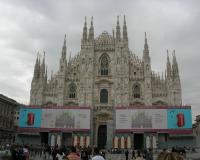places and surroundings
-
SQUARES
- Piazza Mercanti 100 m
-
MONUMENTS - Vedi tutti
- Milan Cathedral 100 m
- Pinacoteca Ambrosiana 0,2 km
- Galleria Vittorio Emanuele II 0,3 km
-
FAIRS
- Milan Trade Fair 10,6 km
-
RAILWAY STATIONS
- Milan Porta Garibaldi Station 2,3 km
- Milan Central Station 2,6 km
- Milan Lambrate Station 4,5 km
-
CLUBS/PUBS/DISCOS
- Cafè Atlantique 2,4 km
- Alcatraz Disco 3,4 km
- Amnesia Disco 3,9 km
- AIRPORTS
Milan Cathedral
Home > Lombardy > Milan > Milan > Milan Cathedral
Inside the Milan Cathedral there is a memorial tablet on which one finds thesse words "The Milan Cathedral was begun in 1386". Apart from this memorial tablet there is no other information which dates prior to December 6th 1387 when Simone da Orsenigo was charged with the role of general engineer.
It is an imposing Gothic-style Cathedral, symbol of the florid dukedom of Milan and the magnificence of Gian Galeazzo Visconti who donated the Condoglia marble quarries from which the pinkish white marble with grey veins was extracted and used for construction. Citizens from all social extractions participated in the building of this Cathedral and one must also remember the considerable fund raising activity which was carried out by Archbishop Antonio da Saluzzo.
On the site where, during the IX century, the Basilica di Santa Maria Maggiore and the church of Santa Tecia once stood, work began on this monumental opera in 1387.
As usual, work began with the apses, and in 1418 it was ready and decorated with sculptures and large windows, even if other work carried on over many centuries.
The imposing building was finished with the positioning of the famous Madonnini, work of Giuseppe Perego, in 1774, on the main spire which dominates the tight line-up of spires and pinnacles (135), gargoyles (150), and marble giants (96): an immense masterpiece comprising 3400 statues.
The Cathedral is illuminated by 164 windows of which 55 are closed by beautiful stained glass windows.
The construction of the Cathedral employed numerous architects and men from all social extractions who alternated over 5 centuries. In fact, the building was finished between 1805 and 1813 and this was the location chosen by Napoleon for his coronation as King of Italy.
Amongst the most famous and important names, one can quote: Pellegrino Tibaldi and Martino Bassi (in the 1500's), Francesco Maria Ricchino, Carlo Buzzi, and Francesco Castelli (in the 1600's), Luigi Vanvitelli and Bernardo Vittone (in the 1700's). However, it is thought that the original mastermind was one because in spite of the alternation of various architects, and the passing of time, the construction maintained a certain style which, it is supposed, derived from the other side of the Alps.
One immediately notices the triangular-like shape of the facade where 6 neo-Gothic buttresses which end in spires, define the five areas of the church. These correspond to the five naves, each with its own doorway and overlooked by tympanum windows.
The Cathedral of Milan can be considered the best possible art gallery thanks to the works inside which date from 1300 to 1800.
Upon entrance one is propelled into semi-darkness due to the scarse difference in height of the naves which leave little space for illumination through the upper windows, and also due to the lack of a triforium.
The inside of the church is studded with 52 pillars which constitute the supportss which hold up the whole structure, and divide the inside into 5 naves: an interesting detail is that most of the pillars have niched capitals which are occupied with statues of Saints.
What one notices is the "trompe l'oeil" painted on the ceiling which seems to be a marble gallery: painted in the 1500's it was repainted during the 1800's.
The Cathedral hosts many important opera's among which: the funeral monument of Gian Giacomo Medici, so-called Meneghino and opera of Leone Leoni (1560-63) with its Michelangelo influence. Also important is the presbitery which is defined by 10 pillars on the side where the apse is found. Whilst recomposing it, the main alter also came into evidence; it belonged to the Church of Santa Maria Maggiore and was reconsecrated for the Cathedral by Pope Martino V in 1418.
A less known detail: in the archaeological excavations carried out by the early Christians, which one can access through a stairway on the counter-facade, there are traces of Saint John's octagonal baptistery where, according to the legend, Bishop Ambrogio baptised Saint Agostino on Easter night in the year 378.
One cannot avoid a visit to the roof balconies from which there is a splendid view of the city of Milan.


